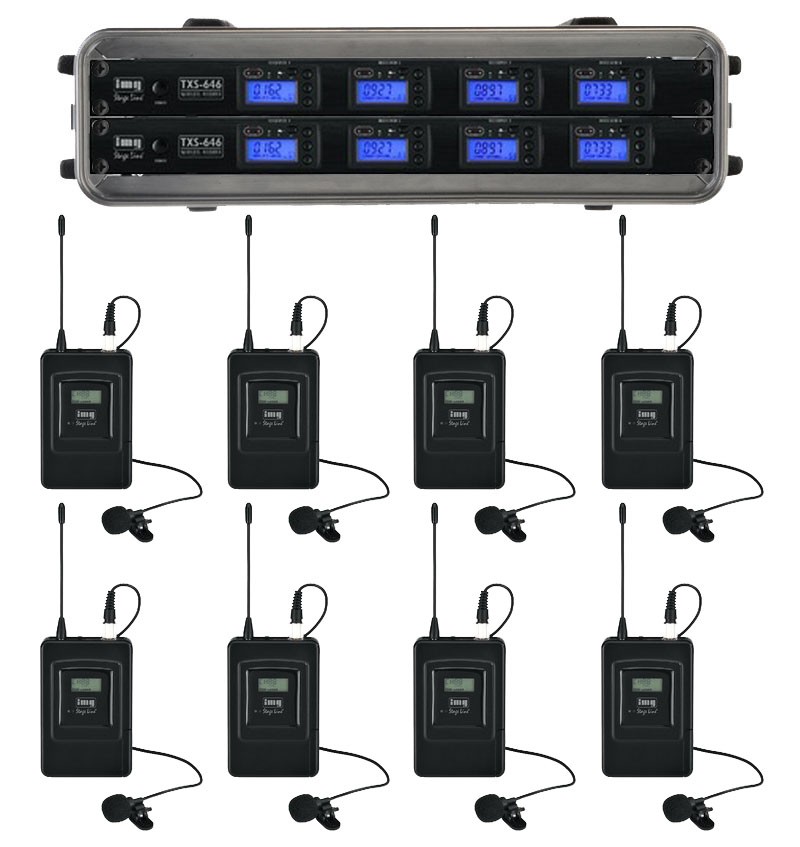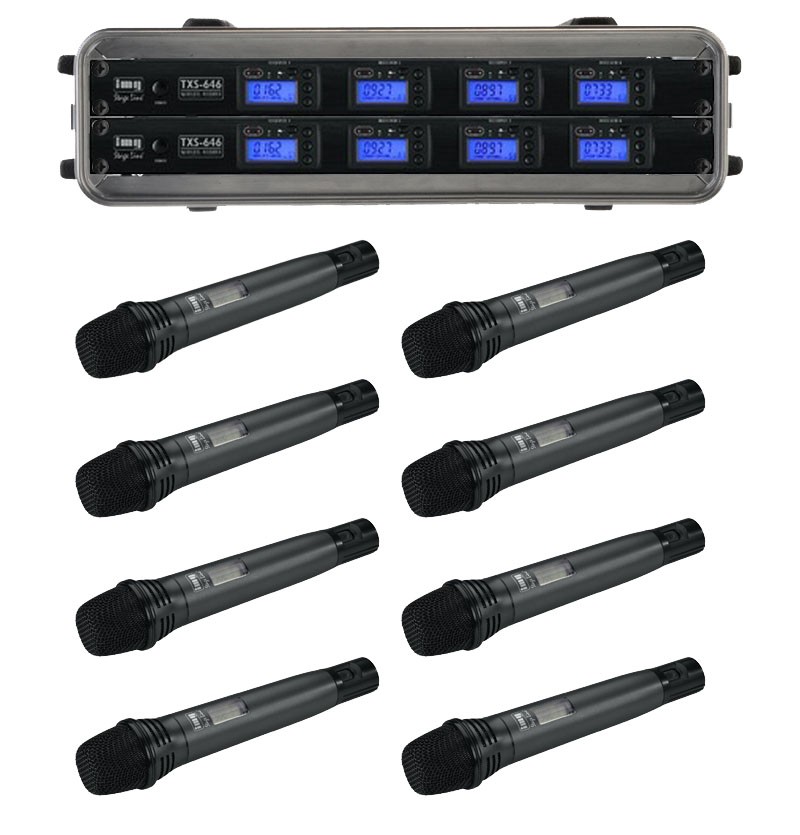Manufacturer Wireless Microphone Frequencies in the UK
Click here to buy wireless microphones
Different manufacturers of wireless microphones use various UHF frequency sets in the UK and abroad. Most makes are incompatible with systems from other manufacturers
Example Set of usable Ch 70 UHF Frequencies
It is possible to get 4 working wireless microphone systems in the deregulated CH 70 band – as an example here is a set of 4 usable frequencies between 863.000MHz and 865.000MHz that have been tested for (their lack of) intermodulation and are recommended by Sennheiser:
Mic 1 863.100 MHz
Mic 2 863.500 MHz
Mic 3 864.300 MHz
Mic 4 864.900 MHz
Wireless Microphone Issues?
This may help if you are having equipment issues
Overview
Wireless microphone systems are also known as wireless mics and sometimes as radiomics, radio-mics, cordless mics, remote mics or roving mics – wireless micr systems need to be connected to a public address PA sound system to work
Channel 65 is the latest set of frequencies for radiomics and wireless microphones here in the UK. It was released in March 2015 as part of a wider EU agreement intended to harmonise the increasing demand for available frequencies for wireless microphone use. These frequencies are included as part of the PMSE Channel 38 Shared License
The quality and price of wireless microphones range from entry level home disco and ‘karaoke’ types costing £100.00 or less right up to thousands of pounds for broadcast quality products. The main differences are in transmission range, reliability of the radio (RF) link, robustness of the hardware, and the audio / sound quality. With the cheapest, don’t expect more than about 20 metres of range – any more, and you’ll get gaps, or drop-outs, in the coverage, which may at worst give you a brief ‘shhhtt’ noise rather than silence
More expensive, and you’ll get a ‘diversity’ receiver with your wireless microphone. Diversity means two separate receivers in one box, with two separate receiving antennas or aerials. The receiver that’s getting the better signal is selected automatically — so there’s a good chance that if one receiver sees a gap in coverage, the other one is still working well – but beware — some cheaper receivers have two antennas but are not diversity
There are three different types of wireless microphone transmitter:
Hand-held transmitters have the microphone and transmitter in the same microphone casing
Add-on transmitters fit on to standard microphones, making them into hand-held wireless microphones
Bodyworn beltpack transmitters allow clothing clip microphones, headworn microphones (headmics) and guitars etc. to connect to a separate wireless microphone transmitter that is worn on a belt or in a pocket
There are two legal radio bands in the UK that do not require a license for use – these are called deregulated frequencies. The older VHF one is between 173.800 MHz and 175.000 MHz (megahertz) – this is often termed ‘legacy frequency’ and the newer UHF one is between 863.000 MHz and 865.000 MHz. The UHF one is a pan-European allocation, but note that other European countries also allocate other bands, so don’t assume that a wireless microphone bought in Europe is legal for use in the UK
Manufacturers label the frequency of their wireless microphones on the equipment and sales literature etc. Naturally, if you are going to use more than one, each needs to have its own frequency. Some wireless microphones allow the user to select from a range of frequencies. Do not assume that you will be able to use all frequencies, as intermodulation distortion and interference are common problems – often it is best to have at least 400 kHz between the frequencies that you are using – 500 kHz between the frequencies is even better
Wireless microphones all need a battery. Some designs use a PP3 9V battery, and operate for a time between 3 and 8 hours from an alkaline battery. Newer types often use a pair of AA or AAA cells and last for 5 to 10 hours. Be aware that the when the battery in a wireless microphone transmitter gets low on voltage (around 8.2v for a PP3, for instance) the wireless microphone audio signal (your voice) will often be muted by the wireless microphone receiver
Wireless Microphones, In-Ear Monitoring (IEM) or Cardio-Theatre?
Although this page is about wireless microphones the concepts apply equally to in-ear monitoring (IEM) and cardio-theatre systems as well – as these use the same UHF radio frequencies. So, when you are thinking about how many channels and licenses you need for your radio equipment don’t just count your wireless microphones consider your in-ear monitors and cardio-theatre systems too
VHF or UHF?
UHF wireless microphones are now preferred over older VHF systems
UHF (Ultra High Frequency) wireless microphones operate between 606.000 MHz and 870.000 MHz whilst VHF (Very High Frequency) types operate between 173.000 MHz and 220.000 MHz. Manufactures are tending to put less effort into VHF systems and all but entry level systems will be using UHF
VHF Frequency and Channels
If you are using VHF systems use frequencies 173.800 MHz to 175.000 MHz as they are license exempt / deregulated and can be used free of charge in the UK. Please be aware that 174.800 MHz tends to have intermodulation problems and if you need to use frequencies other than these you will need a license to operate them in the UK
VHF deregulated frequencies
Anyone can use these deregulated license free frequencies when the equipment is MPT1345/1311 type approved
173.800 MHz
174.000 MHz
174.100 MHz (older systems)
174.200 MHz
174.400 MHz
174.500 MHz (older systems)
174.600 MHz
174.800 MHz – OK on its own but may interfere with other frequencies
175.000 MHz
VHF regulated frequencies
MPT1350 type approved equipment may only be used at the fixed site listed on the license on these frequencies
176.400 MHz
177.000 MHz
192.300 MHz
200.100 MHz
207.700 MHz
208.100 MHz
MPT1350 type approved equipment may be used anywhere in the UK on these frequencies as long as there is a valid license
175.250 MHz – OK on its own but may interfere with other frequencies
175.525 MHz
176.600 MHz – OK on its own but may interfere with other frequencies
191.900 MHz
192.800 MHz
193.000 MHz
199.700 MHz
200.300 MHz
200.600 MHz
208.300 MHz
208.600 MHz
209.000 MHz
216.100 MHz
216.600 MHz
216.800 MHz
UHF Radio Frequencies Used in the UK
Shared frequencies in the UK have been changed and it is quite likely that older equipment may now be illegal to use and you could be face a fine or have your equipment confiscated
There are still free to use frequencies for wireless microphone systems here in the UK such as 2.4GHz and Ch. 70
2.4GHz
2.4GHz is license free in the UK and is also used by Bluetooth, wifi, microwave ovens, DECT phones and wireless DMX devices. 2.4GHz wireless mic systems usually offer a range of up to 20m and between 4 – 8 usable frequencies. There is a possibility of some interference on this frequency band due to the amount of devices using it
1.8GHz
There is also a 1.8GHz frequency band appearing on the market which is free to use in some European countries and now legal to use here in the UK as part of the PMSE Channel 38 Shared License. Unlike 2.4GHz this part of the frequency spectrum is clear of devices such as Bluetooth, wifi routers and wireless DMX etc. and will give better reception over longer distances
UHF TV Ch 70 – 863.000 to 865.000 MHz
Channel 70 is used by devices such as wireless mics, IEMs and wireless headphones along with other devices and remains free to use throughout the UK and EU. Several prestige manufacturers do not recommend the use of these frequencies as they are close to the new 4G mobile phone frequencies
It is possible to get 4 working wireless mic systems in the deregulated CH 70 band – as an example here is a set of 4 usable frequencies between 863.000 MHz and 865.000 MHz that have been tested for (their lack of) intermodulation and are recommended by Sennheiser:
Mic 1 863.100 MHz
Mic 2 863.500 MHz
Mic 3 864.300 MHz
Mic 4 864.900 MHz
UHF TV Ch 69 – 854.000 to 862.000 MHz – Channel 69 is no longer licensable within the UK
UHF TV Ch 65 – 823.000 to 832.000 MHz
Channel 65 is a set of frequencies for radiomics and wireless microphones here in the UK. It was released in March 2015 as part of a wider EU agreement intended to harmonise the increasing demand for available frequencies for wireless microphone use. These frequencies are included as part of the PMSE Channel 38 Shared License
UHF TV Ch 46-48 – 670.000 to 694.000 MHz
Channel 46-48 frequencies can be licensed for radiomics and wireless microphones for fixed site use here in the UK. These frequencies can be part of the PMSE Channel 46 (670.000 to 678.000 MHz), 47 (678.000 to 686 MHz) or 48 (686.000 to 694.00 MHz) fixed site license
UHF TV Ch 38 – 606.000 to 614.000 MHz
Shared with television also used for talkback systems as well as wireless microphones and IEMs
Channel 38 is the safest of the lot if you are a serious user of wireless microphones here in the UK. It is the new dedicated frequency band allocated for their use throughout the UK. You will need an annual license to use it just like the old Channel 69 (UHF 854 – 862MHz) but this will give you up to twelve usable analogue microphone systems within this frequency band depending on the manufacturer you use. More recent digital microphone systems can offer more usable microphones however there is a cost to these systems which can easily top a thousand pounds each so it depends on your budget. In addition to Channel 38 Ofcom have now released Channel 65 (823 – 832MHz) and the 1.8GHz band for radio / wireless microphone use for those who have a Channel 38 license
Range
When higher frequency bands are used you get shorter transmission distance and need a more accurate ‘line of sight’ between the transmitter and receiver
For example 2.4GHz and 1.8GHz offer the shortest range and any obstacles between transmitter and receiver can cause severe disruption of the RF signal
You should be aware the maximum distances the manufacturer quotes are often double what you might expect to achieve in a working system
UK TV channels available for use by wireless microphones and IEMs (as of 2019)
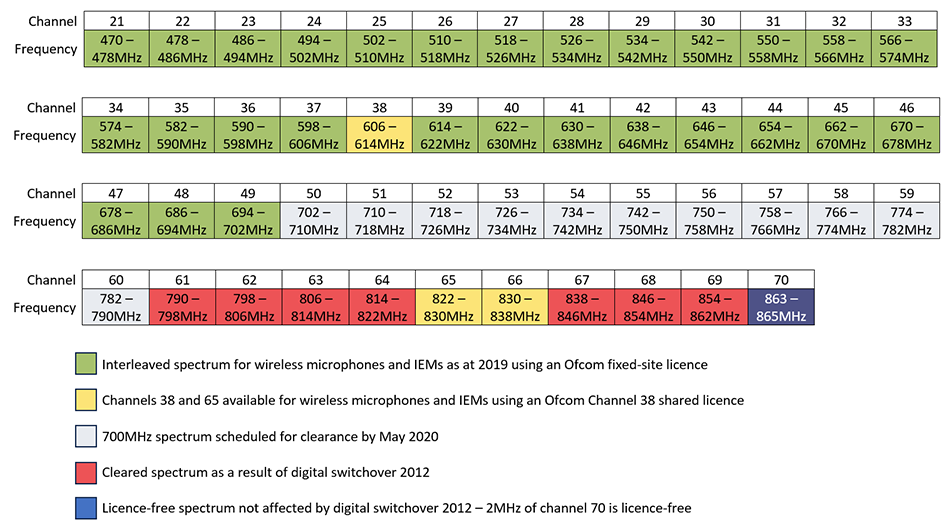
Channel 38 Changeover – Digital Switchover
As a result of the switchover from analogue to digital TV transmission and the consequential reduction of frequency spectrum required, the government released (sold off) some radio spectrum for other purposes. This included frequencies being used by many wireless microphone and in-ear monitoring (IEM) systems – TV Channel 69 (854.000 MHz to 862.000 MHz) was designated for wireless microphones until the end of 2012. A great many wireless products previously sold in the UK operate on Ch 69 are no longer licensable within the UK
Most products operating on Ch 69 also have access to some deregulated spectrum in TV channel 70. This narrow slice of spectrum runs from 863.000 MHz to 865.000 MHz and was not affected by the Digital Switch Over. Only a small number of wireless microphone systems can be used simultaneously on Ch 70, and this depends upon the technical specification of the wireless microphone being used – typically a maximum of 4 systems can be used at the same time
Frequencies within Ch 70 – 863.000 MHz to 865.000 MHz are the only part of the UHF spectrum that can be used without holding a UK license
Licensed users had access to Ch 69 until end of 2012 only
Ch 38 has been named as the only direct replacement to Ch 69. Radio astronomy, which currently holds the license to Ch 38, will be phased out of this band. Ch 38 – 606.000 MHz to 614.000 MHz is available nationwide and, post 2012, Ch 38 is the only shared channel available to wireless microphone users
Channel 70, 65 or 38?
If you are using Channel 70 wireless mics, any changes do not affect you – you can carry on using these systems in the UK or EU
Who was affected by the change?
Anyone running Channel 69 radio mic systems. This frequency band has been reallocated so that the use of radio mics on Ch 69 is no longer legal. Channel 69 was used by most equipment hire companies, travelling theatre productions and other users where more than 3 or 4 wireless mic systems were needed at the same time, and where there is not a fixed location where the mics were being used
Advice for variable location multi-user systems – If you need to run more than 4 wireless devices (and remember that In-Ear Monitor (IEM) and Cardio-Theatre systems are counted as well as wireless and radio mics) then you will need to use Channel 38, either exclusively or in conjunction with other Channel 70 devices. If in doubt please check UK license requirements
Unlike Channel 70, where use of the frequencies do not require a license and are therefore free, Channel 38 systems (in fact all other frequencies) need a license before you can use these systems legally. You can apply for a license online
Channel 65 is the latest released set of frequencies for radiomics and wireless microphones here in the UK. It was released in March 2015 as part of a wider EU agreement intended to harmonise the increasing demand for available frequencies for radio/wireless microphone use. These frequencies are included as part of the PMSE Channel 38 Shared License
What about fixed-site wireless mic systems? So far we have been talking about radio systems which are intended to be used at different sites around the country, but if you are looking for a system that will be permanently installed at a single location, you would be much better advised to look for a coordinated fixed-site license. These licenses are non-shared so do not have the potential to get interference from anyone else trying to use their own radio system on your frequency. This is ideal for theatres, education establishments and houses of worship
Unlike shared licenses, coordinated site licenses can be in a wide range of frequencies, which is dependent upon the exact location of the premises needing the license. A remote site survey is needed to assess the exact requirements. License costs for this type of indoor license start from just £28.00 (as of 2013)
You can purchase a license online. Frequencies can be assigned that are specific for your area – this ensures that other users will be given a separate set of frequencies and you won’t clash. If you use frequencies outside of Ch 70, then you are committing an offence under the Wireless Telegraphy Act if you do not obtain a license
UK Licenses for Wireless Microphones and In Ear Monitoring (IEM)
Do I need a Wireless Microphone License?
Not if you are operating less than four wireless microphones on the deregulated frequencies on Ch 70 between 863.000 MHz and 865.000 MHz
By law you will need be in possession of a license to legally operate wireless microphones on Ch 38, Ch 46 – Ch 48 and Ch 65
Ch 69 is now illegal for wireless microphone use within the UK
If you use frequencies outside of Ch 70 without a license, then you are committing an offence under the Wireless Telegraphy Act if you do not obtain a license
How to Wear a Headworn Microphone
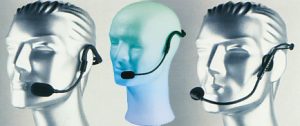
It is important to position a headworn microphone in the correct way – usually the headband goes around the back of your head and the microphone boom arm is on the left of your face
Correct Microphone Handling
Remember – you must still project your voice when using any sort of microphone amplification system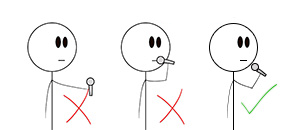
and ALWAYS use the microphone from a position behind the loudspeakers
For live sound it is important to hold your microphone in the correct way
Frequently Asked Questions
Q – My mixer / amplifier has phantom power – can I connect the output of my wireless microphone to the XLR input on my mixer / amplifier?
A – No. Either turn phantom power off or use a different input. Many wireless microphone receivers are not protected from having phantom power connected to their balanced line audio outputs. By connecting a wireless microphone receiver to a mixer or amplifier which has phantom power selected can often damage your receiver in moments
Q – What is the difference between Single channel, Diversity and True Diversity?
A – Single channel receivers have one antenna and one receiver circuit. Diversity receivers have two antennae and a circuit, which selects the strongest aerial signal. True Diversity receivers have two aerials and two totally independent RF receiver modules and a circuit, which selects the best channel for both signal strength and signal-to-noise ratio
Q – How many transmitters can I use with my wireless microphone receiver?
A – Only one. Two transmitters operating on the same frequency will interfere with each other. It is possible to have both a handheld and guitar or clothing-clip mic transmitter on the same frequency, and use them with the same receiver, but not at the same time
Q – How far from the receiver can I place my antenna?
A – As long as you use 50 Ohm fully screened RG58 aerial cable up to ten metres, but the closer the better. It is possible, by employing antenna amplifiers to run longer cables
Q – Can I use my handheld wireless microphone and receiver from different manufacturers if they are on the same frequency?
A – Possibly yes, but careful attention must be paid to specifications, because different makes and models have different technical parameters for equalisation, compression and expansion. Sometimes there are even compatibility issues between different models from the same manufacturer. It would be prudent not to assume compatibility between different manufacturers, unless tried and tested first
Q – Is there a performance difference between UHF and VHF?
A – No – there is little audible performance difference but, with the high demand for a greater number of usable, interference free frequencies, the UHF band offers more opportunities – however the VHF band can often transmit a longer distance without dropouts
Q – What is compression and expansion?
A – The audio signal is compressed (squashed) before being transmitted and the wireless microphone receiver expands the signal back to its original state (size), thereby improving the signal-to-noise ratio and making the signal fit into a smaller slice of radio spectrum
Q – What is FM Modulation?
A – FM is the abbreviation for Frequency Modulation, which is the method of transmitting information by modulating a carrier frequency on a radio transmitter. The frequency of the carrier wave is varied in accordance with the amplitude of the input signal, while the amplitude of the carrier remains unchanged
Q – What is the difference between Squelch and Mute on different wireless microphone receivers?
A – Nothing. A squelch circuit mutes the output of a receiver when the received signal falls too low for good reception. Some units have preset mute levels while others have manual settings. It should be set so that the receiver mutes when the transmitter is switched off, or goes out of range, before the signal is swamped with noise or interference. To achieve a good setting, turn the transmitter off – Set the squelch control to minimum mute level and then mute level until any noise starts to disappear
PA Sound Hire
 PA sound hire in North Hampshire and Surrey border area
PA sound hire in North Hampshire and Surrey border area
Hire public address sound systems for your small to medium sized event in and around North East Hampshire
Please email with your requirements
E&OE





